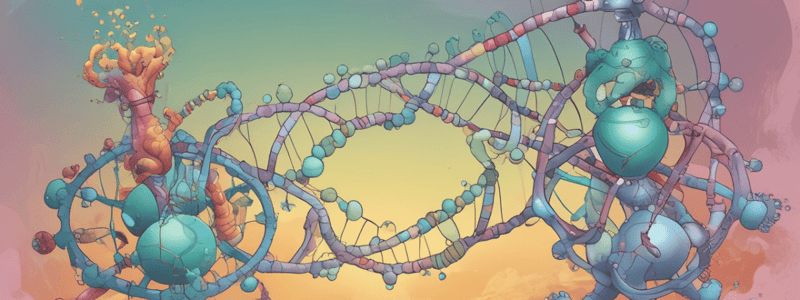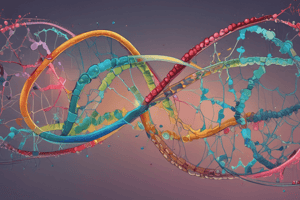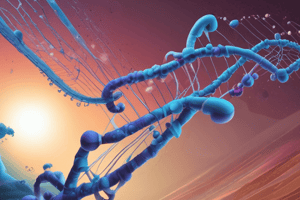Podcast
Questions and Answers
What protects mRNA from 5' exonuclease degradation?
What protects mRNA from 5' exonuclease degradation?
- Intron splicing
- 7-methylguanosine cap (correct)
- Poly(A) tail
- Secondary structures
What is the role of polyadenylate polymerase in mRNA processing?
What is the role of polyadenylate polymerase in mRNA processing?
- Removes the 5' exon
- Adds a 5' cap to the mRNA
- Splices out introns from the mRNA
- Synthesizes the poly(A) tail (correct)
Which sequence is highly conserved and involved in the addition of the poly(A) tail?
Which sequence is highly conserved and involved in the addition of the poly(A) tail?
- (3')UUUUU
- (5')GGGCGG
- (3')CCAUGG
- (5')AAUAAA (correct)
In eukaryotes, which RNA polymerase synthesizes RNA that typically receives a poly(A) tail?
In eukaryotes, which RNA polymerase synthesizes RNA that typically receives a poly(A) tail?
When does the capping of the 5' end of mRNA occur?
When does the capping of the 5' end of mRNA occur?
What is the primary function of introns in pre-mRNA?
What is the primary function of introns in pre-mRNA?
Which process is NOT involved in RNA processing in eukaryotes?
Which process is NOT involved in RNA processing in eukaryotes?
What is the purpose of splicing during RNA processing?
What is the purpose of splicing during RNA processing?
Which RNA polymerase is responsible for the synthesis of mRNA in eukaryotes?
Which RNA polymerase is responsible for the synthesis of mRNA in eukaryotes?
What is the role of TFIIH in the assembly of RNA polymerase?
What is the role of TFIIH in the assembly of RNA polymerase?
During RNA strand initiation and promoter clearance, which transcription factors are released after the initial synthesis of 60-70 RNA nucleotides?
During RNA strand initiation and promoter clearance, which transcription factors are released after the initial synthesis of 60-70 RNA nucleotides?
What is the function of the TATA-binding protein (TBP) in the assembly of RNA polymerase?
What is the function of the TATA-binding protein (TBP) in the assembly of RNA polymerase?
Which RNA polymerase synthesizes pre-ribosomal RNA?
Which RNA polymerase synthesizes pre-ribosomal RNA?
What remains attached to RNA polymerase II during the elongation phase of transcription?
What remains attached to RNA polymerase II during the elongation phase of transcription?
Which feature is characteristic of the Rho-independent terminator?
Which feature is characteristic of the Rho-independent terminator?
Which subunit of the E. coli RNA polymerase is responsible for initiation of transcription?
Which subunit of the E. coli RNA polymerase is responsible for initiation of transcription?
What activity does the Rho factor exhibit in the hot pursuit model?
What activity does the Rho factor exhibit in the hot pursuit model?
What is the function of the Nus A protein during transcription in E. coli?
What is the function of the Nus A protein during transcription in E. coli?
What kind of protein is the Rho factor?
What kind of protein is the Rho factor?
Which process occurs when the RNA polymerase encounters a Rho-independent terminator?
Which process occurs when the RNA polymerase encounters a Rho-independent terminator?
RNA synthesis occurs in three stages. Which stage is NOT one of them?
RNA synthesis occurs in three stages. Which stage is NOT one of them?
What happens when RNA polymerase encounters a transcription-termination signal?
What happens when RNA polymerase encounters a transcription-termination signal?
The -10 sequence in E. coli promoters is also known as what?
The -10 sequence in E. coli promoters is also known as what?
What is the role of the β subunit in the E. coli RNA polymerase?
What is the role of the β subunit in the E. coli RNA polymerase?
In the numbering of a transcription unit, what designation is given to the bases that follow the initiation site?
In the numbering of a transcription unit, what designation is given to the bases that follow the initiation site?
What protects mRNA from 5' exonuclease degradation?
What protects mRNA from 5' exonuclease degradation?
What happens during the RNA chain elongation stage?
What happens during the RNA chain elongation stage?
What is the function of introns in eukaryotic genes?
What is the function of introns in eukaryotic genes?
Which component is not part of the core enzyme of E. coli RNA polymerase?
Which component is not part of the core enzyme of E. coli RNA polymerase?
Which sequence is highly conserved and signals for the addition of the poly(A) tail?
Which sequence is highly conserved and signals for the addition of the poly(A) tail?
At which stage is the 5' cap added to the mRNA?
At which stage is the 5' cap added to the mRNA?
Which enzyme synthesizes RNA in eukaryotic cells up to and beyond the sequence AAUAAA?
Which enzyme synthesizes RNA in eukaryotic cells up to and beyond the sequence AAUAAA?
What happens to introns in the mRNA processing?
What happens to introns in the mRNA processing?
Which of the following occurs first during mRNA processing?
Which of the following occurs first during mRNA processing?
Which components remain in the mature mRNA after splicing?
Which components remain in the mature mRNA after splicing?
Which type of RNA carries genetic information from DNA to the ribosomes?
Which type of RNA carries genetic information from DNA to the ribosomes?
What is the primary function of transfer RNAs (tRNAs)?
What is the primary function of transfer RNAs (tRNAs)?
Which structural form does RNA adopt due to its bulky 2'-OH group?
Which structural form does RNA adopt due to its bulky 2'-OH group?
What component is Polyadenylated at the 3' end?
What component is Polyadenylated at the 3' end?
What is the key role of ribosomal RNAs (rRNAs)?
What is the key role of ribosomal RNAs (rRNAs)?
Which RNA type is specifically involved in RNA interference?
Which RNA type is specifically involved in RNA interference?
What is the primary transcript in eukaryotes?
What is the primary transcript in eukaryotes?
What is RNA synthesis also known as?
What is RNA synthesis also known as?
What enzyme is responsible for RNA synthesis?
What enzyme is responsible for RNA synthesis?
Which direction does RNA synthesis proceed in?
Which direction does RNA synthesis proceed in?
Which characteristic differentiates RNA synthesis from DNA synthesis?
Which characteristic differentiates RNA synthesis from DNA synthesis?
In prokaryotes, which process starts immediately after transcription?
In prokaryotes, which process starts immediately after transcription?
What happens to the pre-mRNA before it becomes mRNA?
What happens to the pre-mRNA before it becomes mRNA?
What molecules will be identical to the DNA non-template (sense) strand?
What molecules will be identical to the DNA non-template (sense) strand?
What components make up a nucleotide?
What components make up a nucleotide?
Which nucleotide base pairs with thymine in DNA?
Which nucleotide base pairs with thymine in DNA?
What is the monophosphate form of guanine in RNA?
What is the monophosphate form of guanine in RNA?
What type of bonds link nucleotide subunits together in DNA and RNA?
What type of bonds link nucleotide subunits together in DNA and RNA?
In the helical structure of DNA, what extends into the centre at right angles to the acids of the helix?
In the helical structure of DNA, what extends into the centre at right angles to the acids of the helix?
Which nucleotide function involves storing genetic information?
Which nucleotide function involves storing genetic information?
How many hydrogen bonds are formed between cytosine and guanine?
How many hydrogen bonds are formed between cytosine and guanine?
Which of the following is not a function of nucleotides?
Which of the following is not a function of nucleotides?
Flashcards are hidden until you start studying
Study Notes
RNA Processing
- Almost all newly synthesized RNA molecules (primary transcripts) are processed to some degree in eukaryotic cells.
- Three major modifications occur:
- The 5'-end is capped with methylguanosine.
- Introns are spliced out.
- Poly-A tail is built at the 3' end.
Capping the 5' of mRNA
- Capping protects mRNA from 5' exonuclease degradation.
- The cap is 7-methylguanosine linked to the 5' end of mRNA.
- Formed by condensation of GTP with the 5' end of mRNA.
- Guanine is then methylated.
- Occurs early in transcription.
Interrupted Genes in Eukaryotes: Exons & Introns
- Most eukaryotic genes contain non-coding sequences called introns that interrupt the coding sequences (exons).
- Introns are excised from the RNA transcripts prior to their transport to the cytoplasm.
Introns
- Introns are non-coding sequences located between coding sequences.
- Introns are removed from the pre-mRNA and are not present in the mRNA.
- Exons are composed of the sequences that remain in the mature mRNA after splicing.
- Introns are variable in size and may be very large.
Placing the Poly(A) Tail on the mRNA
- Pol II synthesizes RNA up to and beyond the highly conserved sequence: (5')AAUAAA.
- An endonuclease cleavage signal sequence is bound by an enzyme complex.
- The RNA is cleaved by the endonuclease at a point 10-30 nucleotides 3' to the sequence AAUAAA.
- The polyadenylate polymerase synthesizes a poly(A) tail.
Key Points
- Three different RNA polymerases are present in eukaryotes, and each polymerase transcribes a distinct set of genes.
- Eukaryotic gene transcripts usually undergo three major modifications:
- Addition of 7-methylguanosine caps to 5' termini.
- Excision of non-coding intron sequences.
- Addition of poly(A) tails to 3' ends.
- All modifications occur in the nucleus prior to the transport to the cytoplasm.
Transcription in Prokaryotes: E. coli RNA Polymerase
Stages of Transcription
- RNA chain initiation.
- RNA chain elongation.
- RNA chain termination.
Promoters
- In E. coli, must be > 12 bp to avoid occurrence by chance.
- Promoters have only small conservation in sequence.
- Four main regions:
- Startpoint.
- -10 sequence (Pribnow box).
- -35 sequences.
- The 17 nucleotide spacer sequence between -10 and -35 sequences.
Numbering of a Transcription Unit
- The transcript initiation site is +1.
- Bases preceding the initiation site are given minus (-) prefixes and are referred to as upstream sequences.
- Bases following the initiation site are given plus (+) prefixes and are referred to as downstream sequences.
Starting Transcription
- Binding of RNA polymerase holoenzyme to a promoter region in DNA.
- Localized unwinding of both DNA strands (around -10 region) by RNA polymerase to provide a single-stranded template.
- Formation of phosphodiester bonds between the first few ribonucleotides in the nascent RNA chain.
- Conformational change in enzyme, promoter is cleared.
- Sigma factor is released.
- Nus A protein binds instead, ready for elongation "antitermination complex".
Termination of Transcription
- RNA polymerase transcribes until it meets a terminator.
- Transcription then stops and the RNA product disassociates from the DNA template.
- Many terminators are hairpin-forming sequences.
- Two types of terminators:
- Rho-dependent terminators - require a protein factor (p).
- Rho-independent terminators - do not require p.
E. coli RNA Polymerase
- Core enzyme: α β β'ω.
- Holoenzyme: α2 β β' ωσ.
- Functions of the subunits:
- α: assembly of the tetrameric core.
- β: ribonucleoside triphosphate binding site.
- β': DNA template binding region.
- σ: initiation of transcription.
Elongation
- RNA polymerase is bound to DNA and is covalently extending the RNA chain.
- Site for incoming ribonucleoside triphosphate.
- Growing RNA chain.
- Rewinding site.
- Short region of DNA/RNA helix.
- Unwinding site.
- Movement of RNA polymerase.
Transfer of Genetic Information: The Central Dogma
- Information stored in the nucleotide sequences of genes is translated into the amino acid sequences of proteins through unstable intermediaries called messenger RNAs.
- The mRNA codons on the mRNA are translated into an amino acid sequence by the ribosomes.
Transcription and Translation in Eukaryotes
- The primary transcript is pre-mRNA.
- A precursor to the mRNA.
- The pre-mRNA is modified at both ends, and introns are removed to produce the mRNA.
- After processing, the mRNA is exported to the cytoplasm for translation by ribosomes.
General Features of RNA Synthesis
- Similar to DNA synthesis except:
- The precursors are ribonucleoside triphosphates.
- Only 1 strand of DNA is used as a template.
- RNA chains can be initiated de novo (no primer required).
- The RNA molecule will be complementary to the DNA template (antisense) strand and identical to the DNA non-template (sense) strand.
- RNA synthesis is catalyzed by RNA polymerases and proceeds in the 5'-3' direction.
The Central Dogma
Prokaryotes
- Gene
- DNA
- Transcription
- mRNA
- Translation
- Protein
Transcription vs. DNA Replication
- RNA does not remain H-bonded to the DNA post-synthesis.
- RNA molecules are selective copies of much shorter segments of the DNA.
- Both employ polymerases.
- to make phosphodiester linkages.
- DNA ahead of synthesis is unwound.
- Building blocks are very similar to each other.
- RNA polymerase does not need a primer.
The "Transcription Bubble"
- DNA 3'
- Rewinding
- Template strand
- Transcription bubble
- Nontemplate strand
- RNA
- RNA-DNA hybrid, -8bp
- Active site
- Direction of transcription
- Unwinding
- NTP channel
Studying That Suits You
Use AI to generate personalized quizzes and flashcards to suit your learning preferences.




